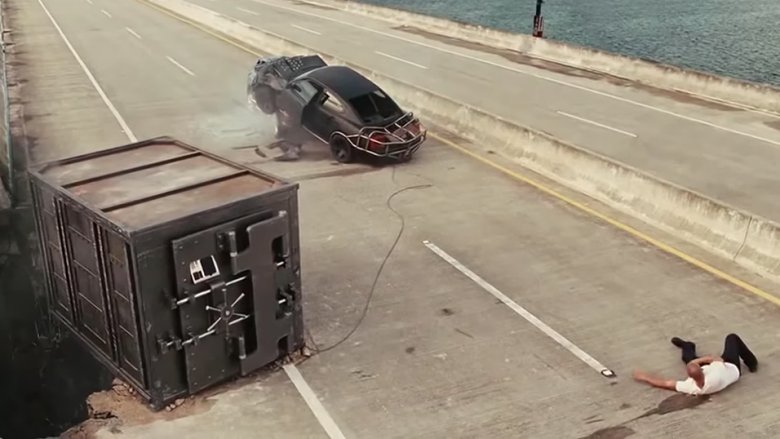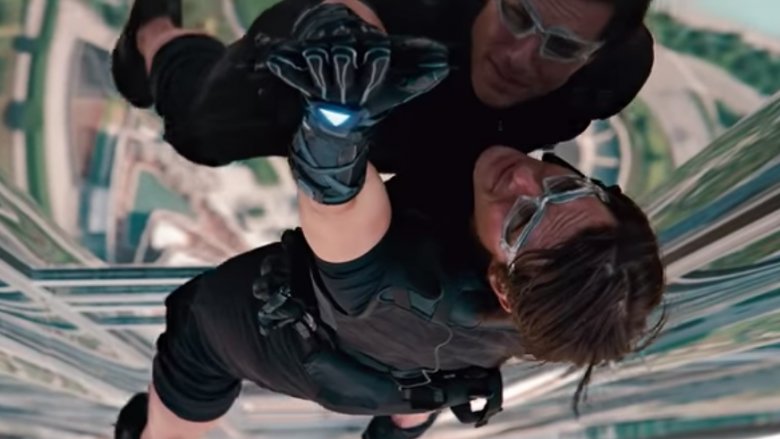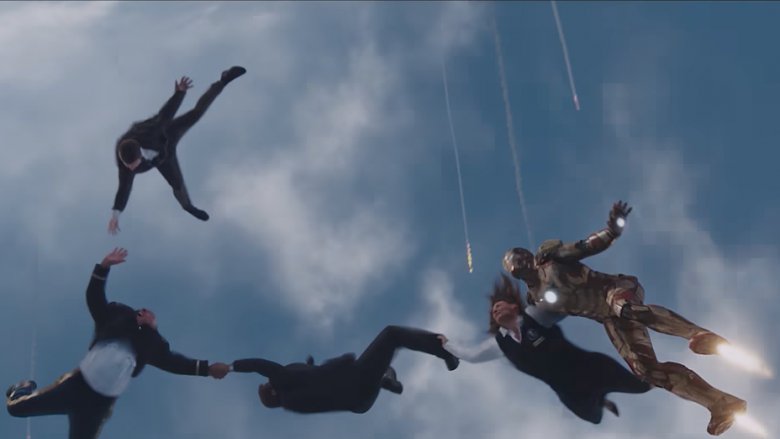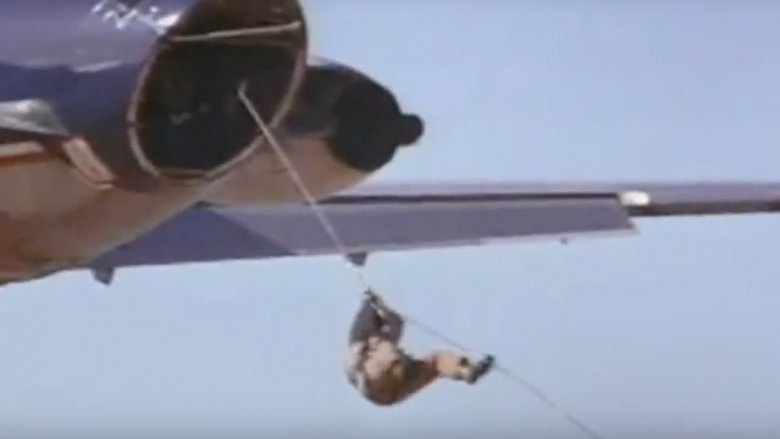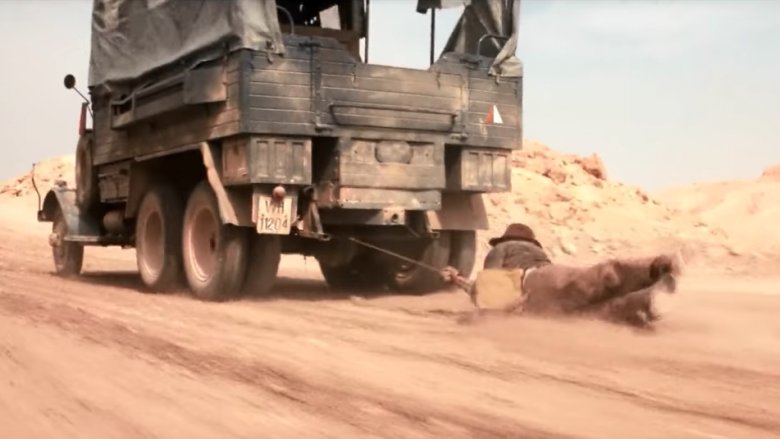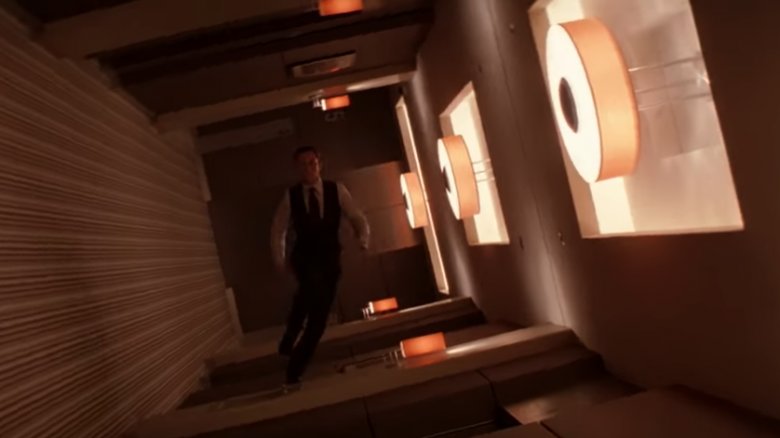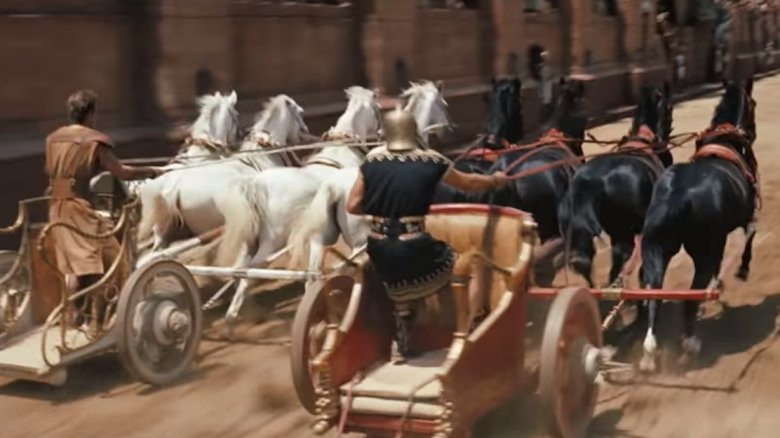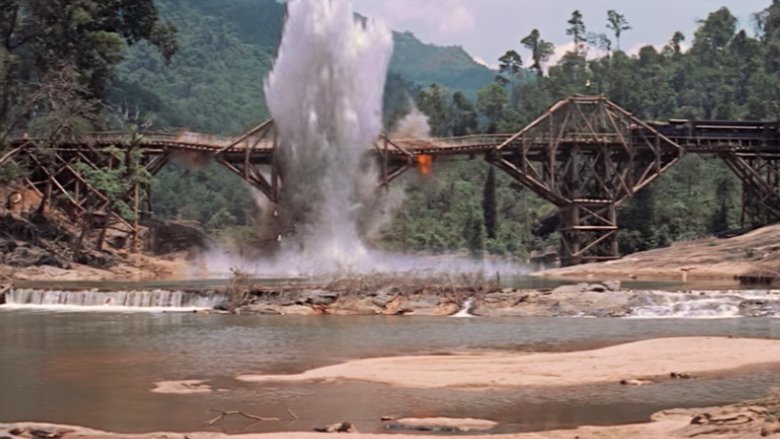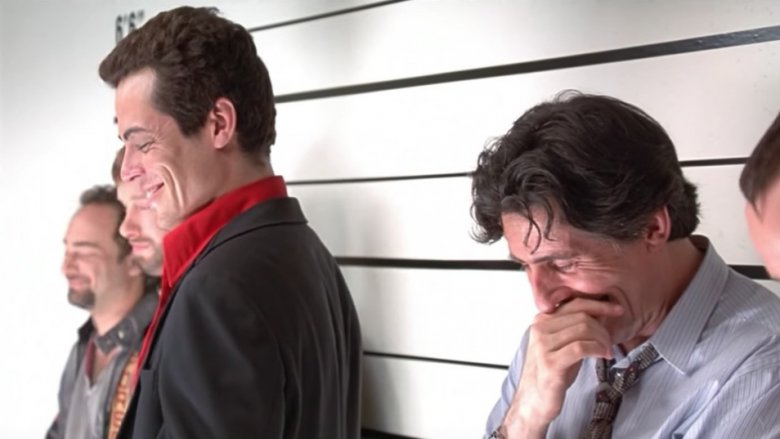Iconic Movie Scenes That Were Nearly Impossible To Capture
You need only watch a behind-the-scenes video or two to understand that making movies is hard work. From the long hours to having to coordinate complex and dangerous stunts, every angle of filmmaking comes with a litany of challenges. The bigger or more intricate the scene, the more challenges arise, which makes it all the more impressive when you think about the ways that some of the most iconic, thrilling film scenes of all time came together.
The work that goes into staging a particularly complex stunt or reeling in the performances of bombastic actors is massively challenging to directors. For these moments to come together despite all the factors working against them is incredible, and learning about what was going on behind the scenes to ensure these moments stuck their landing only makes us appreciate them even more. Here's a look at some iconic movie scenes that were nearly impossible to capture on film.
Fast Five's heist of the century
Fast Five is a standout entry in the Fast and Furious franchise. It's at its best during its climactic car chase through the streets of Rio de Janeiro as Dom and Brian haul a 100-ton bank vault with the police hot on their tail. It's so big and bombastic that it's totally understandable to assume it's mostly CGI. That said, not only was it all practically shot, but those bank vaults are pretty much the real deal.
Director Justin Lin was adamant about using as little CGI as possible, so stunt coordinator Jack Gill started by seeing if they could attach a real vault to the cars. At 80,000 to 100,000 pounds this ended up being a no-go, so Gill and his team built a replica vault that weighed in at 10,000 pounds — so heavy that the cars couldn't actually move it. They dealt with this by swapping out the Dodge Challengers they were using for ones with bigger tires and 400-horsepower engines, then built several more vaults — one for crashing into buildings, another solely for driving, and one that even had a tractor inside to direct its movement. If all this sounds dangerous, it is. As Gill said, "All it takes is one missed cue and somebody gets killed." Luckily, everyone finished the shoot safe and sound.
Mission: Impossible Ghost Protocol dangles by a thread
The Mission: Impossible franchise has more or less become a series of films in which audiences watch actor Tom Cruise cheat death for real over and over. We've seen him latch himself to a plane prepping for takeoff, and in Mission: Imppossible – Fallout he pulled off a tremendously ambitious skydiving stunt. However, they pale in comparison next to the tower-climbing sequence in Mission: Impossible – Ghost Protocol, another stunt that, against all odds, Cruise performed himself.
This sequence sees Cruise's Ethan Hunt climbing the exterior of the Burj Khalifa, the tallest building in the world, well over 100 stories above ground. Cruise, apparently at peace with the prospect of dying over a spy movie, fired the film's insurance company so he could perform the climb without a stunt double. With only some rigging keeping him from falling, Cruise performed the stunt with no rehearsal on the actual Burj Khalifa, only a 50-foot replica built off-set. What's more, when it came time for the moment in which Hunt leaps from the side of the building and then lands back on it with only a rope for support, there was no way to rig it so Cruise's landing would be cushioned. He just went ahead and did it, landing full force on the glass. Learning about the story behind this stunt is enough to convince us that Tom Cruise isn't mortal.
Iron Man 3 dives in
The Marvel Cinematic Universe is full of killer stunt work, but there are some easy standouts. Among them is a sequence that looks completely computer-generated: the breathtaking "Barrel O' Monkeys" airplane rescue set piece from Iron Man 3.
The stunt was going to be performed in a studio with greenscreen, but after some prodding from stunt coordinator Jeff Habberstad, the filmmakers examined the logistics of shooting it practically. They brought on the highly skilled Red Bull Skydive Team and began with two days of testing at the airport to make sure pulling it off would be plausible. Once they determined it was, the divers had to dress in civilian clothes with parachutes sewn into the fabric and make the dive without goggles. It began about 12,000 feet up, which is "about as high as they can jump without oxygen," according to VFX Supervisor Erik Nash. They proceeded to make the jump seven or eight times a day for six days, all alongside a cameraman with a Red video camera mounted on their head. Any stunt involving skydivers is going to be precarious, and with this many diving at once from such a great height it would have been totally understandable for the filmmakers to just call it quits and do it with a greenscreen. Their resilience resulted in a genuinely thrilling action sequence.
Cliffhanger flies high
There was a time before CGI provided an easy fix to filmmaking. Stunts had to be performed practically, or at least with practical visual effects. If you don't do well with heights, few films from that era will make you queasier than Cliffhanger.
The film centers around Sylvester Stallone as a mountain climber mixed up in an airplane heist. It's full of daring climbs and aerial stunts, most of which were performed for real by talented actors and stuntmen. There's a particular sequence that stands out as the most impressive: the airplane transfer. The scene involves a character traveling from one airplane to another via a single cable — airplanes in motion three miles above the ground. The planes had to travel at an exact speed of 150 miles per hour each. If either sped up, stuntman Simon Crane could have been ripped in half. The altitude and wind created numbing temperatures as well, with Crane having to don a special prosthetic face mask in order to endure the cold. He was equipped with two parachutes in case anything went wrong, but beyond that safeguards were scarce. There wasn't even a safety harness. Crane managed to pull the stunt off almost perfectly, save for some trouble getting pulled into the second plane. It's as breathtaking now as it was in 1993.
Raiders of the Lost Ark takes Indy for a ride
Raiders of the Lost Ark, the film that introduced audiences to Harrison Ford's Indiana Jones, is chock full of some of the most memorable imagery in film history. From the opening boulder sequence to the moment we all learned to never bring a sword to a gunfight, it's a ride unlike any other. One particularly famous stunt, however, proved more difficult than others. The sequence in which Jones crawls under a moving truck and is then dragged through the dirt road, clinging to the whip he's fixed to the underbelly for dear life, wasn't just difficult to film. A similar stunt had nearly killed Ford's stuntman Terry Leonard just a few months prior.
It began with a five-ton truck moving at full speed. The crew then dug a small ditch along the truck's path so as to allow Leonard more maneuverability. The most difficult part, though? Convincing Leonard to do it at all. He eventually agreed to it on the condition that his friend, stunt coordinator Glen Randall, be the one to drive the truck.
Despite its brevity — Leonard only drifts under the truck for six seconds — it was immensely dangerous. Leonard, thankfully, came away unscathed, pulling off what would become known as one of the great stunts of all time.
Inception goes for a spin
The standout action sequence of Inception is as thrilling as it is inventive. Joseph Gordon-Levitt's Arthur fighting a handful of guards as gravity shifts and twists around them is a stunning sequence, one you'd think would have to involve a lot of wire work and CGI. Surprisingly, that's not the case. The scene was shot practically with a rotating set resembling the one utilized in 2001: A Space Odyssey.
The crew started by fabricating a series of massive motor-operated metal rings. As the set was built, cameras were installed in the floors and walls to properly capture the action without sacrificing the quality of the lighting. Finally, the performers had to, well, perform it. Gordon-Levitt only had two weeks to rehearse complex fight choreography that was difficult enough on its own. Throw in a rotating set and the potential for motion sickness if you lose your focus, and you've got one crazy difficult fight to shoot. The complications continued as the shoot moved to the rotating hotel room which, being a larger space, became far riskier as a misstep could lead to a ten-foot fall. Sure, they could have just used CGI, but as Gordon-Levitt said, "There's no substitute for real human energy in performance."
Ben-Hur goes off to the races
Shooting a biblical drama in the 1950s offered very little room for cinematic sleight of hand, especially when it came to one as epic in every sense as Ben-Hur. Everything from the stunts to the massive crowds of extras had to be shot and arranged practically. This proved especially difficult when it came time to shoot the film's famous chariot race.
The race took nearly a year to prepare, from the million-dollar arena set carved out of an actual quarry by a thousand workmen to lead actor Charlton Heston having to learn how to drive an actual chariot. The shoot also required nearly a hundred trained racehorses — who, as it turned out, ran faster than the car carrying the camera. This gave the cameramen only a few seconds to get each shot, even with an ample head start. The heat limited the horses to eight runs a day, and a stunt gone wrong very nearly resulted in stuntman Joe Canutt being trampled by his horses and chariot (Canutt somehow managed to escape with only a cut on his chin). Despite everything, the filmmakers and crew managed to pull the whole thing off. We'd say for that alone, they deserved all 11 Oscars the film received.
Apocalypse Now has trouble taking off
Apocalypse Now's turbulent shoot is among the most notorious in Hollywood's history. Director Francis Ford Coppola himself has said that as the shoot trudged on, "little by little we went insane." It went over budget and over schedule, perpetually at the precipice of falling apart, and the film's helicopter napalm strike sequence serves as particularly compelling evidence.
Right away, the crew ran into issues. The U.S. government wouldn't lend the necessary helicopters unless there were changes to the script, which Coppola refused. They ended up getting the choppers from the president of the Philippines, who was facing a very real rebellion during the shoot. As such, fewer helicopters were provided than promised, and many had to be returned. Furthermore, the Philippine pilots behind the choppers hadn't been trained to fly on film, resulting in difficulty choreographing and filming the flight paths. There were also volatile pyrotechnics to deal with, including more than 1200 gallons of gasoline for the napalm strike. To top it all off, the surfers hired to ride waves in the background ended up not even knowing how to surf. Apocalypse Now nearly broke Coppola, but the end result is a film that captures the chaos and nihilism of war in ways that remain unparalleled.
The Bridge Over the River Kwai is falling down
Any time you demolish or damage an irreplaceable prop on film, your margin for error is tight. For example, if you're going to blow up a bridge that your crew built from scratch, you'd better make sure you get it in one take. Thanks to some intense preparation (and a small miracle), director David Lean got it in two takes in The Bridge Over the River Kwai.
First, the crew built a dam to ensure the river's water levels would be low enough to shoot in. Unfortunately, heavy rains brought the water up anyway, and the shoot had to be postponed for 11 days. Then, in order to get enough footage of the bridge blowing up, the crew set up five cameras to film it — only to suffer a malfunction during the shoot. The train was already running and couldn't just stop; fortunately, it crashed into a generator truck, a happy accident that salvaged the scene. Shooting the stunt may not have been outwardly chaotic, but the nonexistent margin for error — and the fact that there was an error, only saved by luck — makes it all the more impressive that Lean pulled off the film's climactic set piece so well.
The Usual Suspects lines 'em up
Short of its killer twist ending, the scene most commonly associated with The Usual Suspects is the police lineup that brings the protagonists together. Heck, it's the image they used for the poster. It's an immensely memorable moment in which five criminals make a simple police lineup as difficult as possible for the cops who bring them in on trumped-up charges. The characters bicker and banter, making the ordeal exhausting for all involved. It's even funnier when you learn the story behind why it was nearly impossible for director Bryan Singer to film.
The scene was supposed to be played totally straight, full of drama and tension. The only problem? Kevin Spacey, Stephen Baldwin, Gabriel Byrne, Benicio del Toro, and Kevin Pollak couldn't stop laughing and breaking character. It got so bad that Singer read them the riot act during their lunch break, which only made things worse. Allegedly the fits of laughter started due to del Toro dealing with some, um, internal issues. Whatever it may have been, the resulting chaos forced Singer to just use the funnier takes in the finished film. It may not have turned out the way he envisioned, but it's hard to deny that it ended up working perfectly.
